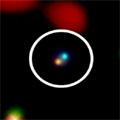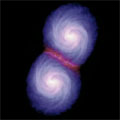CXC Home | Search | Help | Image Use Policy | Latest Images | Privacy | Accessibility | Glossary | Q&A

Chandra's X-ray Image of Black Holes in the Early Universe
QuickTime MPEG This sequence begins with the Chandra Deep Field-North, the deepest X-ray image ever taken. Black holes that are also found in submillimeter observations, indicating active star formation in their host galaxies, are then marked. The view then zooms onto one pair of particularly close black holes (known as SMG 123616.1+621513). Astronomers believe these black holes and their galaxies are orbiting each other and will eventually merge. The sequence ends by showing an animation of this scenario.
[Run time: 0:33]
(Animation: X-ray image: NASA/CXC/Penn State/D. Alexander et al.)
QuickTime MPEG This sequence begins with the Chandra Deep Field-North, the deepest X-ray image ever taken. Black holes that are also found in submillimeter observations, indicating active star formation in their host galaxies, are then marked. The view then zooms onto one pair of particularly close black holes (known as SMG 123616.1+621513). Astronomers believe these black holes and their galaxies are orbiting each other and will eventually merge. The sequence ends by showing an animation of this scenario.
[Run time: 0:33]
(Animation: X-ray image: NASA/CXC/Penn State/D. Alexander et al.)

Simulation of a Galaxy Collision
QuickTime MPEG This visualization shows two spiral galaxies - each with supermassive black holes at their center - as they collide. In this simulation, the brightness represents gas density while the color indicates temperature in the gas distribution. The latest Chandra results suggest that such collisions may cause extreme black hole and galaxy growth in the early Universe, setting the stage for the birth of quasars. The time scale shown in the upper left of the simulation represents millions of years.
[Run time: 0:41]
(Simulation: Tiziana Di Matteo (MPE/CMU), Volker Springel (MPE) & Lars Hernquist (Harvard))
QuickTime MPEG This visualization shows two spiral galaxies - each with supermassive black holes at their center - as they collide. In this simulation, the brightness represents gas density while the color indicates temperature in the gas distribution. The latest Chandra results suggest that such collisions may cause extreme black hole and galaxy growth in the early Universe, setting the stage for the birth of quasars. The time scale shown in the upper left of the simulation represents millions of years.
[Run time: 0:41]
(Simulation: Tiziana Di Matteo (MPE/CMU), Volker Springel (MPE) & Lars Hernquist (Harvard))
Return to Submillimeter Galaxies in the Chandra Deep Field-North (SMG 123616.1+621513) (06 Apr 05)


